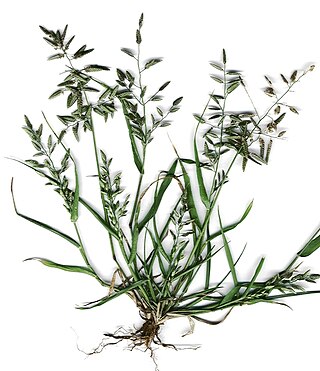
Eragrostis is a large and widespread genus of plants in the grass family, found in many countries on all inhabited continents and many islands.

Molinia, or moor grass, is a genus of two species of flowering plants in the grass family, native to damp moorland in Eurasia and northern Africa. They are both herbaceous perennial grasses.

Echinochloa is a very widespread genus of plants in the grass family and tribe Paniceae. Some of the species are known by the common names barnyard grass or cockspur grass.

Grindelia squarrosa, also known as a curly-top gumweed or curlycup gumweed, is a small North American biennial or short-lived perennial plant.

Banksia squarrosa, commonly known as pingle, is a species of prickly shrub that is endemic to Western Australia. It has linear to narrow lance-shaped leaves with up to ten sharply-pointed teeth on each side, yellow flowers in heads of about sixty and later, up to seven oblong to egg-shaped follicles in each head.

Imperata is a small but widespread genus of tropical and subtropical grasses, commonly known as satintails.
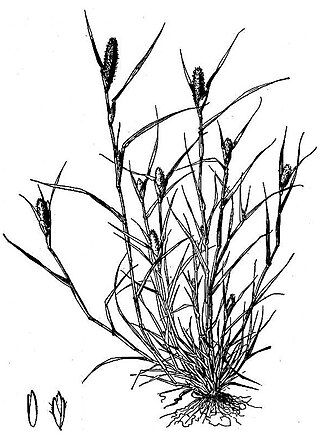
Crypsis is a genus of African and Eurasian plants in the grass family, sometimes referred to as pricklegrass. These are annual grasses with short leaves. A few species are invasive weeds outside their native ranges.

Lolium multiflorum is a ryegrass native to temperate Europe, though its precise native range is unknown.
Banksia squarrosa subsp. squarrosa is a subspecies of Banksia squarrosa, commonly called "pingle". As an autonym, it is defined as encompassing the type material of the species. It was known as Dryandra squarrosa subsp. squarrosa until 2007, when Austin Mast and Kevin Thiele sunk all Dryandra into Banksia. As with other members of Banksia ser. Dryandra, it is endemic to the South West Botanical Province of Western Australia.

Elymus pungens, the sea couch grass, is a species of grass of the genus Elymus in the family Poaceae. It is a common grass species native to Europe and Asia. Elymus pungens is typically found in sandy, and saline environments and can tolerate harsh weather conditions; because of this it is a common pioneer species typically associated with sand dunes.
Sickle grass is a common name for several plants and may refer to:

Pogonarthria is a genus of African plants in the grass family.
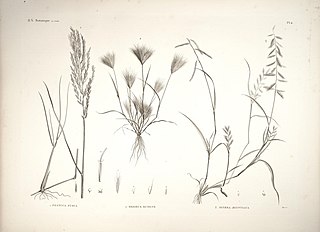
Dinebra is a genus of Asian, African, and Pacific Island plants in the grass family.
Ixophorus is a genus of Latin American plants in the grass family. The only recognized species is Ixophorus unisetus. Some authors have included one or two other species in the genus, such as I. pringlei, but these have more recently been reduced to synonymy. Common names for I. unisetus include crane grass, turkey grass, Honduras grass, Mexican grass, Central America grass, hático (Colombia), zacate blanco, and zacate chompipe (Nicaragua).
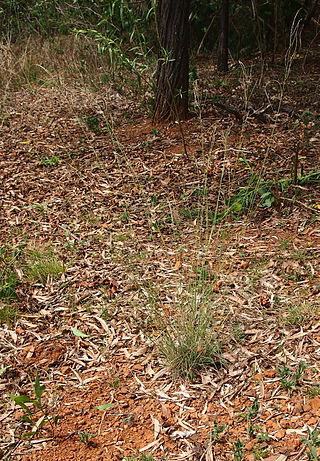
Leptochloa is a widespread genus of Asian, Australian, and American plants in the grass family.
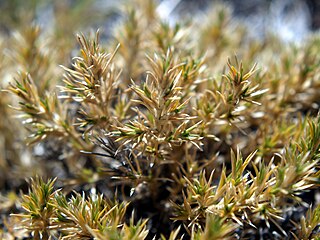
Munroa is a genus of New World plants in the grass family, native to North and South America.

Munroa squarrosa is a species of grass known by the common name false buffalograss. It is native to North America from central Canada to Chihuahua in Mexico. It can be found in many types of dry, open habitat, including disturbed areas.

Pholiota squarrosa, commonly known as the shaggy scalycap, the shaggy Pholiota, or the scaly Pholiota, is a species of mushroom in the family Strophariaceae. Common in North America and Europe, it is a secondary parasite, in that it attacks trees that have already been weakened from prior injury or infection by bacteria or other fungi. It has a wide range of hosts among deciduous trees, although it can also infect conifers. It can also live as a saprobe, deriving nutrients from decomposing wood.
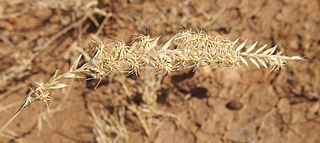
Astrebla squarrosa, commonly known as bull Mitchell grass, is a long lived herb of the family Poaceae. It is often seen growing to 1.5 metres (5 ft) tall. Its common name is one bestowed in honour of Thomas Mitchell. The plant can be found on floodplains and heavy dark clay soils in arid to semi-arid Australia, being regarded as the most flood tolerant of the Astrebla grasses. Flowering occurs in response to rain. The coarse stems and difficult digestibility make it a less desirable Mitchell grass for livestock.

Catabrosa aquatica, called brookgrass, water whorl-grass, water whirlgrass and water hairgrass, is a widespread species of semi-aquatic grass in the genus Catabrosa, native to most of the non-tropical northern hemisphere, and to southern Chile and Argentina. As its scientific and common names suggest, it prefers to grow in wet areas, such as meadows, stream banks and lake shores.
















